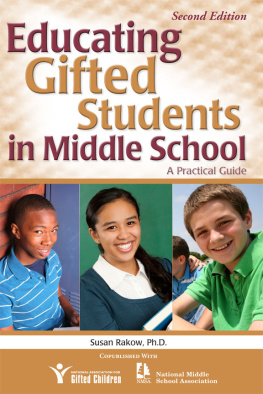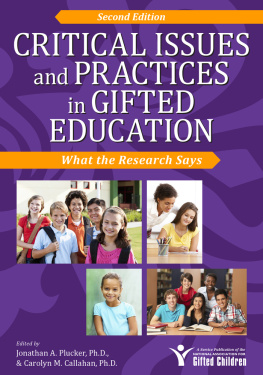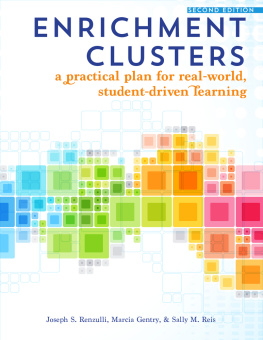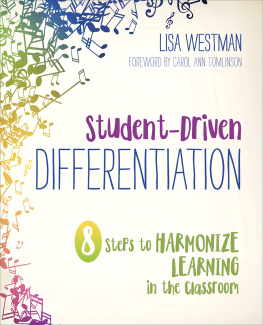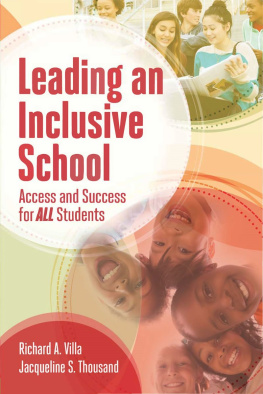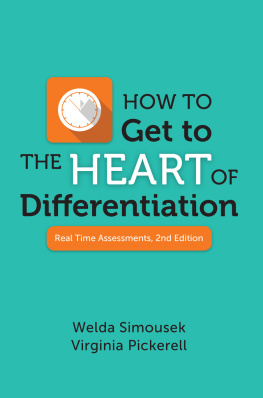

Copyright 2014 Prufrock Press Inc.
Edited by Bethany Johnsen
Cover and layout design by Raquel Trevino
ISBN-13: 978-1-61821-237-5
No part of this book may be reproduced, translated, stored in a retrieval system, or transmitted, in any form or by any means, electronic, mechanical, photocopying, microfilming, recording, or otherwise, without written permission from the publisher.
At the time of this books publication, all facts and figures cited are the most current available. All telephone numbers, addresses, and website URLs are accurate and active. All publications, organizations, websites, and other resources exist as described in the book, and all have been verified. The authors and Prufrock Press Inc. make no warranty or guarantee concerning the information and materials given out by organizations or content found at websites, and we are not responsible for any changes that occur after this books publication. If you find an error, please contact Prufrock Press Inc.
 | Prufrock Press Inc. P.O. Box 8813 Waco, TX 76714-8813 Phone: (800) 998-2208 Fax: (800) 240-0333 http://www.prufrock.com |
Table of Contents
Acknowledgements
I would like to acknowledge and thank my graduate school mentors, Sally M. Reis, Joseph S. Renzulli, Robert K. Gable, Steven V. Owen, Karen Westberg, and E. Jean Gubbins, whose guidance, teaching, and support made the work on this model possible. I am fortunate and proud to have studied with each of you. Sally, your encouragement resulted in this work; thank you. I would also like to thank the many school district administrators and teachers who have successfully implemented this model; they have added to our knowledge base concerning how to effectively use Total School Cluster Grouping, and I draw from their experience in this book.
Special recognition goes to my research team members, colleague Kristina Ayers Paul, and Ph.D. candidates Jason McIntosh, C. Matthew Fugate, and Enyi Jen, who each contributed chapters and their best thinking to this book. They provide an invaluable source of inspiration to me. A very special thanks goes to Dr. Bill Asher, Professor Emeritus from Purdue University and Gifted Education Research Institute advisory board member, whose generosity and encouragement allowed us to continue our research, even when grant funds were cut. I credit Bessie Duncan, whose work with cluster grouping in the Detroit Public Schools in the 1980s laid the foundation for the development of this model.
I am grateful for the support of my family and friends. I dedicate this book to my daughter, Gentry Lee, whose journey though school provides me daily with a fresh perspective of our educational system. This work is for her and other students who, like her, deserve the best education that we can provide them.
Marcia Gentry
Foreword
I am delighted that this important, practical, easy-to-read manual has been so well received, and that the author has agreed to revise and update it with all of the new information about how cluster grouping can be implemented. This edition provides new and updated information as well as new research for teachers and administrators who are interested in using cluster grouping. This type of grouping can be an essential service for gifted and high potential students as well as a method for more effectively and efficiently meeting the broad instructional needs of all students. Why is this so critical? My colleague Janine Firmender and I studied reading levels in fourth-grade classrooms across the country, finding that in most, reading levels range across 11 grades! How can one teacher handle such a broad range of reading achievement levels? The answer is simplehe cannotunless he uses a strategy such as cluster grouping.
The author of this book points out a critical truth about cluster grouping: Grouping alone has little, if any, effect on academic gains and other outcomes. Educators must first group and then differentiate with appropriate enrichment and acceleration activities and strategies. The more limited range of achievement levels in a classroom (four rather than 11 grade levels, for example) will enable teachers to focus and differentiate the curriculum, materials, process, and products specifically to meet all of their students needs and characteristics. Marcia Gentrys research on cluster grouping has proven that this practice raises achievement and promotes talent development in a broader range of students. When grouped appropriately and given differentiated instruction, students are able to make continuous progress.
The strategies discussed in this book are based on sound educational research, research that is sorely missing in too many books and articles about educational and instructional interventions. I recommend it to all educators who are interested in challenging and engaging their students and in ensuring that every student makes continuous progress in school.
Sally Reis, Ph.D.
University of Connecticut
Introduction
My work with what has become the Total School Cluster Grouping Model (TSCG) began in earnest in the late 1980s with the implementation, development, and refinement of the model. I studied the model in the 1990s and found that all students in schools where the model was implemented benefited from the model by achieving at higher levels and by having their teachers recognize them as higher achieving. I also found that classroom teachers implemented strategies and curriculum typically reserved for use in gifted programs with all students. Since then, I have helped many school districts across the country implement this model. My original research has served as a foundation for larger-scale research, program implementation, and evaluation studies conducted by myself and by other researchers. We have received evaluation, research, clinical and anecdotal reports of achievement, identification, and teacher practice results similar to those we found and reported. Due to the continued popularity and increased implementation across the country, we have continued to study and evaluate the effects of TSCG, each time finding strikingly similar results. Additionally, we have developed a website filled with resources based on what we have learned in the past 25 years to assist educators in their implementation efforts (http://www.purduegeri.org).
Total School Cluster Grouping offers educators a common-sense, whole-school approach to student placement, staff development, and differentiation. This model uses talent-development approaches typically found in gifted education programs to improve the achievement and performance of all of the children in the school. As such, this model focuses on what students can do and how educators can enhance every students strengths, skills, and confidence by using grouping and enriched instruction.
The second edition of this book represents the culmination of our knowledge to date of the best way to implement this model in elementary schools with two or more classes per grade level. In it, we provide the rationale for and specifics of the TSCG model together with suggestions for staff development, evaluation, and differentiating curriculum and instruction. concludes with a thoughtful chapter on the importance of and steps for program evaluation.
Next page


